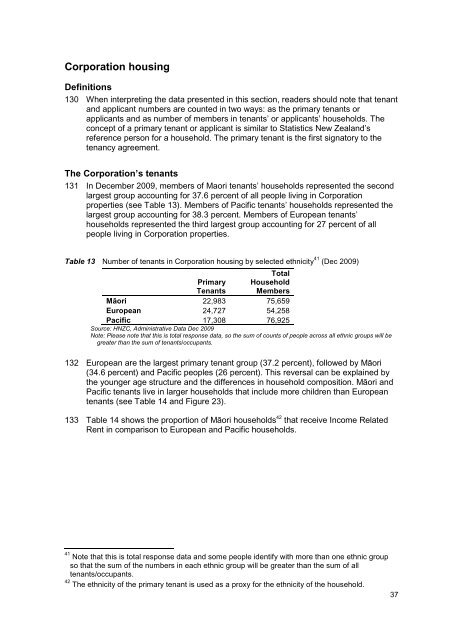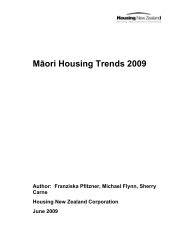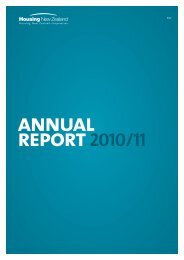MÄori Housing Trends 2010 - Housing New Zealand
MÄori Housing Trends 2010 - Housing New Zealand
MÄori Housing Trends 2010 - Housing New Zealand
You also want an ePaper? Increase the reach of your titles
YUMPU automatically turns print PDFs into web optimized ePapers that Google loves.
Corporation housingDefinitions130 When interpreting the data presented in this section, readers should note that tenantand applicant numbers are counted in two ways: as the primary tenants orapplicants and as number of members in tenants’ or applicants’ households. Theconcept of a primary tenant or applicant is similar to Statistics <strong>New</strong> <strong>Zealand</strong>’sreference person for a household. The primary tenant is the first signatory to thetenancy agreement.The Corporation’s tenants131 In December 2009, members of Maori tenants’ households represented the secondlargest group accounting for 37.6 percent of all people living in Corporationproperties (see Table 13). Members of Pacific tenants’ households represented thelargest group accounting for 38.3 percent. Members of European tenants’households represented the third largest group accounting for 27 percent of allpeople living in Corporation properties.Table 13 Number of tenants in Corporation housing by selected ethnicity 41 (Dec 2009)TotalPrimaryTenantsHouseholdMembersMāori 22,983 75,659European 24,727 54,258Pacific 17,308 76,925Source: HNZC, Administrative Data Dec 2009Note: Please note that this is total response data, so the sum of counts of people across all ethnic groups will begreater than the sum of tenants/occupants.132 European are the largest primary tenant group (37.2 percent), followed by Māori(34.6 percent) and Pacific peoples (26 percent). This reversal can be explained bythe younger age structure and the differences in household composition. Māori andPacific tenants live in larger households that include more children than Europeantenants (see Table 14 and Figure 23).133 Table 14 shows the proportion of Māori households 42 that receive Income RelatedRent in comparison to European and Pacific households.41 Note that this is total response data and some people identify with more than one ethnic groupso that the sum of the numbers in each ethnic group will be greater than the sum of alltenants/occupants.42 The ethnicity of the primary tenant is used as a proxy for the ethnicity of the household.37














